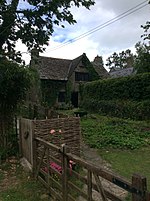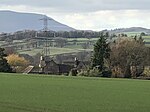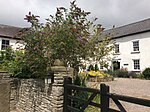Upper White Castle Farmhouse
Country houses in WalesFarmhouses in WalesGrade II* listed buildings in MonmouthshireGrade II* listed houses in Wales

Upper White Castle Farmhouse, Llantilio Crossenny, Monmouthshire is a farmhouse dating from the late 17th century. Standing adjacent to the White Castle, the farmhouse is constructed in a Renaissance style. The farmhouse is Grade II* listed, and some of the related farm buildings have their own listings.
Excerpt from the Wikipedia article Upper White Castle Farmhouse (License: CC BY-SA 3.0, Authors, Images).Upper White Castle Farmhouse
Geographical coordinates (GPS) Address Nearby Places Show on map
Geographical coordinates (GPS)
| Latitude | Longitude |
|---|---|
| N 51.8452 ° | E -2.9006 ° |
Address
NP7 8UD , Whitecastle
Wales, United Kingdom
Open on Google Maps











